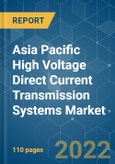The Asia-Pacific (APAC) high voltage direct current (HVDC) transmission systems market is expected to witness a CAGR of around 4.5% during the forecast period. The COVID-19 outbreak severely affected the market due to the reduced power demand caused by the suspended economic activity worldwide. The electricity consumption in the commercial and industrial sector in the Indian state of Telangana reduced from 70 MU in 2019 to 60 MU in 2020, which resulted in heavy losses for power distribution companies and led to their reluctance to go for new power transmission projects. The market’s growth is attributed to the reliable transmission of high power loads for long distances and efficient transmission with low T&D losses. However, the high installation cost is likely to hinder the market’s growth in the coming years.
The Asia-Pacific high voltage direct current (HVDC) transmission systems market is moderately fragmented. Some of the key players include Hitachi Energy India Ltd, Bharat Heavy Electricals Ltd, General Electric Company, Siemens Energy AG, and Mitsubishi Electric Corporation.
This product will be delivered within 2 business days.
Key Highlights
- The underwater segment is expected to witness significant growth in the future due to various upcoming HVDC submarine projects queued up in the region.
- The increasing power demand from developing countries like China and India is likely to have a catalytic effect on the market in the future. In 2020, the electricity consumption in China was around 7,510 TWh, the highest globally.
- China is expected to dominate the market during the forecast period due to the country's constantly growing power transmission network.
Key Market Trends
Underwater/Submarine Segment Expected to Witness Significant Growth
- The HVDC submarine power transmission system is a crucial technology for developing future power transmission networks. A converter station at each end is required to make the DC interact with the AC grid network. It is the only solution available to transfer high power across long subsea distances. The submarine transmission of electricity is gaining importance due to the increasing focus on power trading between countries.
- The technology is projected to strengthen its foothold in the region mainly due to the development of the offshore renewable power generation sector in Asian countries. Wind energy projects captured the largest share. The global offshore annual wind capacity was around 5 GW in 2020, out of which China's update was recorded at 2.6 GW, the largest share. Many other countries were engaged in such renewable power trading agreements through the sea route.
- For example, in March 2021, Japan's Ministry of Economy, Trade, and Industry hinted at plans to call for proposals to lay HVDC undersea power cables for offshore wind farms for the development of renewable energy projects in the country. The first blueprint is planned for power transmission from Hokkaido to the Tokyo region through the coastline of the Pacific Ocean.
- In October 2021, Australia announced plans to supply solar power to Singapore via the offshore route after generating power from a 10 GW solar power plant. The high-voltage, direct current (HVDC) electric power cable project will be undertaken by SunCable company, which will first transmit 3 GW to Darwin on the Australian Northern Territory through the 800 km power line, and thereon, it would transfer 2.2 GW of power through a 3700 km underwater power line. It is expected to be completed by 2027.
- Such developments support the prediction that underwater or submarine HVDC power transmission systems will hold a significant share in the coming years.
China Expected to Dominate the Market
- China is projected to ace the market in the coming years due to increased power demand driven by the economic growth and growth in population. The country witnessed the highest electricity demand in the residential, commercial, and industrial sectors in the last decade.
- As of 2020, the electricity generation in the country was around 7,779 TWh, the highest among all the Asian countries. The transmission network growth was parallel to the power generation growth to develop the infrastructure and support the high power generation. The country witnessed the deployment of HVDC transmission systems generally for renewable power integration in the national grid.
- In April 2020, the State Grid Corporation of China (SGCC) offered a contract to ABB Ltd for the provision of advanced HVDC converter transformers, high-voltage equipment for three 800 kilovolts (kV), and ultrahigh-voltage direct current (UHVDC) transmission links for integrating hydro, wind, and solar power in the electricity grid of Nanchang and East China. The 1,700-kilometer Yazhong-Nanchang link project is a part of a major initiative called China’s West-East Electricity Transmission. It is expected to be completed within two years.
- The SGCC got one more HVDC project commissioned in the same year, the Shanbei-Wuhan Link project. The 1,100-km-long Shanbei-Wuhan link will transmit up to 8,000 MW of electricity to the grid of the two provinces in the country’s North West and Central regions. The project includes installing high-voltage equipment for SGCC's 800-kV transmission link.
- Thus, China is likely to become the most dominant player in the Asia-Pacific region during the forecast period due to the increasing adoption of HVDC transmission projects.
Competitive Landscape
The Asia-Pacific high voltage direct current (HVDC) transmission systems market is moderately fragmented. Some of the key players include Hitachi Energy India Ltd, Bharat Heavy Electricals Ltd, General Electric Company, Siemens Energy AG, and Mitsubishi Electric Corporation.
Additional Benefits:
- The market estimate (ME) sheet in Excel format
- 3 months of analyst support
This product will be delivered within 2 business days.
Table of Contents
1 INTRODUCTION
4 MARKET OVERVIEW
5 MARKET SEGMENTATION
6 COMPETITIVE LANDSCAPE
Companies Mentioned (Partial List)
A selection of companies mentioned in this report includes, but is not limited to:
- Hitachi Energy India Ltd
- Bharat Heavy Electricals Limited
- General Electric Company
- Siemens Energy AG
- Mitsubishi Electric Corporation
- Toshiba Corp.
- Adani Transmission Ltd
- Power Grid Corporation of India Ltd
- Tata Power Company Limited
- TAG Corporation








